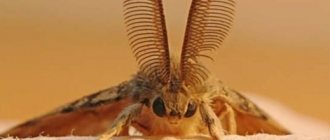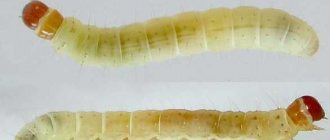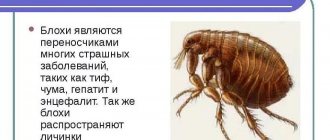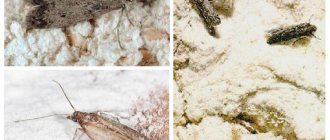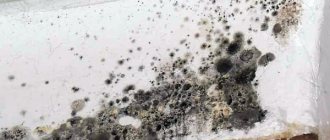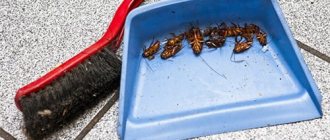The problem of moths in the kitchen is quite relevant and every housewife wants to know how to combat it. Many people have stocks of cereals and products in their kitchens, because it is much easier to buy a large quantity at once than to go shopping every day. But if these stocks are at risk and can be destroyed by small insects, it is worth thinking about how to get rid of moths.
What does it look like
Not all city residents have any idea what a poplar moth looks like.
If a small butterfly with small dots on its wings flies into the room, then most likely it is a moth. Her wings are narrow, framed with fringe. The distance from the apex of the left wing to the apex of the right in an adult pied moth reaches 7 mm. The color of the butterfly is not particularly attractive - it has a brown tint.
Insects mate in the spring, towards the end of April, and lay eggs in May. After 10 days, the eggs hatch into caterpillars. A young individual reaches an average length of 5 mm. Their color can be white or light yellow, so they are practically invisible against the background of young greenery.
When a moth enters a living space, its primary task is not to obtain food, but to create ideal conditions for subsequent reproduction. This is extremely necessary given how long the insect lives (only 60–72 hours).
During this time interval, an adult individual manages to make 2–3 clutches. Moths look for hidden places to lay eggs. A good option are containers with cereals, dried fruits and flour.
The pest fly can cause psychological discomfort and some inconvenience, but it is not the most terrible insect that can significantly ruin a person’s life.
Prevention and means of getting rid of moths
Although food moths are not a threat to your wardrobe, this should not be reassuring. After all, clothes moths and food moths can share spheres of influence in a friendly manner. And while the owner is desperately studying information on how to fight moths in the kitchen, his favorite sweater is happily being eaten by clothes moths in the closet. Thus, the problem of how to get rid of food moths in an apartment should be approached comprehensively. How to deal with house and food moths?
For indoor moths, you should shake out your clothes and remove any falling larvae, warm your clothes in the sun and treat them with special aerosols. For prevention, ventilate things in the fresh air more often, keep them clean and periodically treat furniture with disinfectants. To destroy existing moths, aerosols such as “Raptor” or “Mosquitol” are on sale, as well as “Antimol” plates and solutions for protecting furniture and carpets “Morimol”, “Foxide” and others.
Before answering the question: how to remove food moths, you should know about the factors of insect reproduction. The conditions for the reproduction of food moths is a damp room with poor ventilation, so food should be stored in tightly closed and, most importantly, dry containers. How to get rid of moths in cereals? Unfortunately, the discovery of moths in cereals or other bulk products means only one thing - the products will have to be thrown away.
However, discarding, unopened and contaminated food will prevent further pest spread. Unfortunately, getting rid of food moths in the kitchen is much more difficult than getting rid of indoor moths. In this case, the use of chemicals is unacceptable due to the risk of poison getting on food products. It is for this reason that pest control requires patience and the complete destruction of spoiled food. Trouble: how to get rid of moths in the kitchen should be solved step by step.
It is better to start with an inventory of products in which the presence of moths is indicated by lumps, cobwebs and gray plaque. Thoroughly drying the cereal or nuts in the oven will help get rid of the larvae. However, it is still recommended to get rid of contaminated products. Wipe kitchen cabinets with soapy water, treat with vinegar and ventilate. You can also use an effective moth repellent in the kitchen - the smell of citrus fruits, lavender, bay leaves, garlic, basil, geranium, cloves, wild rosemary, tansy, fir and rosemary.
Cotton pads soaked in the right aromatic oils placed in cabinets will help remove pests. For butterflies, you can use Aeroxon traps or sticky tape. Thus, the problem of how to get rid of food moths in the kitchen, although not simple, is solvable. Read the article about the fight against cockroaches “What types of cockroaches are there and where to buy them?”
The methods listed are effective against food house moths. However, they will be useless, for example, for furniture moths or lovers of the popular vegetable - potato moth, which causes damage on a larger scale.
Methods to combat black moths
There are different methods of controlling food moths. One of them is the disinfection of kitchen units, tables and cabinets in which food is stored. To carry out this procedure, prepare a soap solution. They treat all types of surfaces. After time, it is washed off with water. The cracks and joints are treated with vinegar.
The products are returned to their places a few hours after the surfaces have dried.
Cereals and flour should be thermally processed by placing them in the oven or microwave. The duration of drying is determined by the type of cereal, as well as the equipment used. Products intended for cleansing are placed in special food containers or glass containers.
Folk remedies
Moths do not like the smell of essential oils, especially lavender. To combat the pest, it is recommended to place a small piece of gauze soaked in lavender oil in the closet. As an alternative, dried branches of the plant can be used.
In addition, the insect does not like odors:
- kerosene;
- tobacco;
- strawberry soap;
- garlic;
- orange
Folk remedies kerosene.
Fabric bags must be filled with any of the above substances (except the first) and placed in the closet. Garlic is most often placed inside a container with cereal.
Chemicals
Chemicals also help in the fight against moths, including:
- anti-moth sections;
- sprays;
- plates;
- pills;
- briquettes
The last three positions are the most affordable. They contain 2 substances:
- naphthalene;
- camphor.
Mothballs for moths.
Substances are placed on the top shelves of cabinets so that the vapors they emit go down and prevent the reproduction of insects.
The period of their influence lasts six months. Using this method you can get rid of moths, but cause harm to human health. Before using the tablet, you need to wrap it in a thin cloth.
Sections are an effective method of controlling these pests. In addition, they are easy to use, but you must first read the instructions for use. For one room of 15 m² you need to use one section. It should be placed away from food products and out of the reach of children. Before use, you need to remove the tape, and then place it in the upper compartment of the cabinet (preferably in the corner).
Most suitable scents:
- chamomile;
- mandarin;
- lavender.
The smell of chamomile from moths.
Upon expiration, the section is replaced with a new one. To avoid the negative effects of this product on health, you should follow the recommendations specified in the instructions.
Sprays and aerosols are not used to treat food products. They are used to destroy nests of insect larvae located in kitchen furniture. Before this procedure, uncontaminated products should be removed from shelves.
How to identify a black moth
This moth resembles a gray moth in appearance, but its color is much darker. It is easy to detect the presence of this pest in the house, because... male moths fly around the room in search of food. At this time, females are looking for a suitable place to lay eggs.
The eggs of this insect have a silvery tint. Newly hatched caterpillars have a body several millimeters long and their life cycle ranges from 1 to 3 weeks. They settle in food products, spoil and eat them. After a short period of time, the caterpillars reach 1.3 cm and turn into a pupa. The next stage is rebirth into a butterfly.
Description, life cycle and reproduction
The moth looks inconspicuous: it is a small butterfly of golden yellow or straw color, the wingspan is 15 mm. The insect is afraid of daylight, so it leads a nocturnal lifestyle. During her life cycle, the female manages to lay about 300 eggs. Flying butterflies do not harm clothes. Their digestive system does not function; they only consume water. The danger is posed by small caterpillars - the larvae of household moths.
Knowing how the pest reproduces, you can take preventative measures. At home, the insect prefers to breed in the folds of clothing. Females love dry and warm habitats. After mating, the female is ready to lay eggs within four hours. The higher the temperature, the faster the larvae will hatch from the eggs. Moths in apartments feed on keratins, which they obtain from home textiles: woolen fabrics, fur coats, fabric pads in furniture, curtains and carpets. She is especially attracted to worn clothes with traces of dirt and sweat.
The larvae have a translucent or light yellow body color, due to this the entire contents of their stomach are visible. There are eight short legs on the abdomen; the caterpillar's head is brown. The larvae reach a length of 12 mm, have powerful jaws and a voluminous digestive system. Thanks to this, clothes quickly become unusable, leaving gnawed tracks on the product.
If you see a flying clothes moth, then it is a male. Females do not know how to fly, they stay in one place, and the males fly to them themselves, finding them by a specific smell.
Reasons for the appearance of the house
A moth cannot appear out of nowhere. There are several main ways pests can enter a house or apartment:
- food moths can be brought with contaminated products (there may be eggs or larvae of the pest in flour or cereal);
- Moths can be contaminated with used furniture, carpets, and second-hand clothes;
- the insect can also get into the house on new clothes if pests live in the store or warehouse;
- through the ventilation duct from the neighbors.
Another option is that moths fly in from the street through a window. However, given that insects do not fly well, such cases are extremely rare.
Preventive measures
It is very difficult to finally get rid of the pest once and for all, because it not only spoils food, but also multiplies. The eggs that the moth lays transform into larvae after some time. The process of getting rid of an insect can take a long time, unless you decide to throw away absolutely all products, even those that, at first glance, are not contaminated and then treat everything with appropriate substances.
It is better to prevent a pest from appearing in the kitchen than to get rid of it for a long time. And doing this is not as difficult as it might seem at first glance. There are several ways to prevent moths from appearing in your kitchen:
- It is better to purchase all products, in particular cereals, dried fruits, nuts and the like, in trusted, reputable stores. In this case, the chance that you will bring a parasite into your home is much less.
- It is best to review the purchased products. If there are unusual balls or lumps in the cereal, be careful, because these could be eggs or moth larvae and in this case it would be better to get rid of the possibly contaminated product.
- To be more sure, the cereals can be placed in the microwave at maximum power for 40 seconds or in the oven at a temperature of at least 65 degrees for 30-40 minutes. Using this method, you can be sure that the products are safe for consumption.
Thus, getting rid of the pest is not so difficult, but to do this you need to follow simple rules so as not to infect the kitchen and food. After all, it is much easier to regularly carry out certain preventive measures than to overcome food moths.
Originally posted 2018-03-11 11:46:46.
Appearance of the pest
For many decades, these small moths have been considered by people to be among the most inveterate pests both in the domestic environment and in agriculture. However, today we will talk exclusively about domestic species of these insects, such as clothes moths and food moths.
Both species are almost identical in appearance. This is an inconspicuous and inconspicuous-looking butterfly, most often of a grayish-pale color, which cannot even be called a color. It's like a powdered, light yellow or just gray moth, without any traces of beauty, as they say.
Although there are still some differences between these two species. Usually the food variety is darker in color than the wool variety. The kitchen moth has brownish blotches on its wings, while the house moth is completely light-colored.
The body length of these butterflies usually does not exceed 1 cm. They are poor flyers and have difficulty moving through the air over long distances. We can say that these are endemic to interior spaces, such as living rooms, kitchens, warehouses, storage rooms, verandas and the like.
What does the pest eat?
Black moth is a dangerous parasite that destroys a number of foods, among which the most favorite are poorly processed grains, dried apricots, mushrooms and nuts.
Pests, as a result of their feeding, leave traces of vital activity on spoiled food, which renders the food unsuitable for further use. The black moth deforms the grain shell and destroys endosperms and embryos.
This type of parasite prefers to live inside chocolates, seasonings that are used as a spice to improve the smell and taste of food, loose tea, and crackers. It is worth noting that in the bags where grain is stored, the moth weaves a web in layers reaching a depth of 10 centimeters.
Difference between food moth and clothes moth
All small butterflies seem alike
But since the methods of controlling pests of products and fabrics differ, it is worth taking into account a number of differences that will help determine what type of moth you encountered
- Habitats. If butterflies appear in the kitchen, these are food moths. The clothes bird is not interested in food: it is not suitable for eating or laying eggs in it. But a pest that spoils food will not cause damage to clothing.
- Size (food grade larger).
- Color. Unlike the clothes moth, which is lighter with a golden-sand tint, the food moth is darker, and its wings have brownish-gray tones.
How to recognize an insect
The greatest damage from the pest occurs in urban green spaces. The main food is poplar, but the parasite does not ignore other plants.
You can recognize an insect by its characteristic features, including:
- Leaf fall. Moth colonies eat the foliage, causing it to fall prematurely and the branches to freeze. In such cases, many trees die.
- Moves of different configurations. Depending on the type of tree or plant variety, the pestle makes pinpoint punctures, bizarre passages of white and yellowish colors, and grinds off the entire surface.
- Through holes in young leaves (mines). The caterpillars choose a place for pupation in fresh greenery, eating large holes with a diameter of 1.5-2 cm.
- Spots on the crown. Damaged plates quickly turn yellow, fade and fall off.
Poplar leaves damaged by moths.
Old trees are more difficult to tolerate pest invasions.
What kind of pest is this and why is it dangerous to humans?
Food moths are parasites that attack food supplies. The pest is a small flying insect whose body length varies from 7 to 10 mm. Outwardly it looks like a small gray-brown moth.
Due to its inconspicuous color, the parasite remains unnoticed among products for a long time and multiplies quickly. The pest prefers to live in the kitchen in drawers and cabinets where cereals and groceries are placed.
Since the insect is omnivorous, it can eat fruits and vegetables, dried herbs, and spices. The main threat to food products is larvae of the parasite. Adults do not eat anything, since they do not have mouthparts or a digestive system.
The risk group includes:
- rice, millet, buckwheat and other cereals;
- raw pasta;
- rolled oats, bran;
- prunes, dried apricots, raisins, nuts;
- flour and baked goods;
- sugar, cocoa, dry tea.
The reproduction cycle of the parasite is quite short - under favorable conditions, the caterpillar transforms into a butterfly in 43-45 days. The lifespan of adults is 3-4 weeks. An adult female lays an average of 300-350 eggs during her life.
The display is carried out directly in the cereals or on the packaging with them. The eggs of the parasite are so tiny that they cannot be seen with the naked eye. The eggs hatch into larvae - caterpillars, which pose the main threat to food. During their life, the larvae weave a web to form a cocoon, from which a butterfly then emerges.
The main reason for the occurrence of a parasite in an apartment is unsanitary conditions. Despite this, the pest often appears in apartments where ideal cleanliness is maintained - it often appears in the kitchen after purchasing contaminated products. Therefore, supplies should be purchased only from trusted retail outlets and, preferably, not in bulk.
Before purchasing, you need to inspect the packaging - it must be intact. Another reason why food moths can appear in the kitchen is through ventilation from neighbors. The pest often changes its habitat in search of new food. There is virtually no chance of food moths entering the kitchen through an open window.
This insect is not dangerous for humans. Moths do not bite and do not carry infections that can cause harm to the body. In addition, she does not eat clothes made from natural fabrics, so you don’t have to worry about their integrity. Moths only harm products: cereals, tea, sugar, dried fruits.
You should not eat contaminated foods, as this can cause:
- intoxication of the body;
- the appearance of allergies;
- decreased immune defenses.
It makes no sense to sort through or wash contaminated foods, since larvae will still remain on them, so they are not suitable for food.
Where does it come from in the apartment?
Black moths often appear in an apartment by accident. Enters through an open window and then finds a secluded place for himself. People often bring it along with store-bought cereal.
There may be no worms at the time of purchase, but after some time moths will begin to flutter around the kitchen. If you examine these cereal packages, they are filled with caterpillars and moths.
Often cereals become infected in the warehouse due to the fault of workshop workers. When a person brings such grains home, ideal conditions are created for moths. Sometimes infection also occurs from unscrupulous neighbors. Pests enter through vents, drains, or other pathways.
Where do moths come from in the house?
After these unpleasant winged neighbors began to appear more often than usual, we need to find out which species they belong to.
The sanitary condition of the house in such cases is not at all important. Moths grow in neglected, crowded barracks and rich houses
The main and only thing that attracts her is the food supply. The food supply is directly related to moth species.
There are only two of them:
- clothes moth
- Food moth
why do moths appear in the house
Despite the obvious resemblance to butterflies, moths do not fly well. That is why it rarely enters the house on its own, although sometimes it can rise through the ventilation from neighbors. Most often it is brought by the apartment owners themselves. The path by which moths enter a room depends on the species.
Food moths enter the apartment practically on the hands of the housewife - in products purchased at the store. She prefers foods such as seeds, milk mixtures, as well as pet food and various cereals. You can also find moth eggs in dried herbs, berries and fruits.
Factory packaging usually cannot guarantee that the purchased product is free of moths. Typically, tears and other damage to the packaging or improper storage of the product in a factory, warehouse or store lead to the proliferation of this flyer. If the apartment is located above a store that stores cereal stocks, this can lead to the emergence of winged pests in all apartments of a residential building.
How do clothes moths get into houses? Like her "sister", she sneaks into the house inside the shopping. Basically, its larvae can be found on things made of natural wool, fur, as well as on natural furniture upholstery. Unfortunately, it is almost impossible to insure yourself against purchasing clothes or pieces of furniture with larvae. Even expensive stores that carefully monitor the quality of goods cannot protect all items from this pest. With the purchase of furniture that has already been used, the risk of introducing moth larvae only increases.
There is another way that moths manage to get into an apartment - on the fur of dogs. This method is used only by adults. Although the pest does not feed on the wool itself, it can penetrate it and “enter” the house. She especially loves to “travel” on dogs with long, matted hair.
In order for the moth to feel comfortable in the house, it must have all the conditions necessary for it:
- Food. The availability of food determines whether the pest can reproduce. Without the necessary food supply, the moth will complete its life cycle and will no longer disturb with its presence.
- Suitable habitat. Moths do not like daylight or open spaces. She needs closed, preferably dark, cabinets and drawers. It can also be found in kitchen cabinets and pantries, places where it can live close to a food source.
- No drafts and half-light.
- No unpleasant odors. Paradoxically, this tiny pest is sensitive to strong odors such as citrus, tobacco or eucalyptus with lavender.
Spraying moths' favorite places to live with liquids with these odors will serve as good prevention against the pest.
Preventive actions
To prevent black moth larvae from appearing in the room, you need to keep food in closed containers made of glass or metal. It is allowed to place cloves of garlic, walnut leaves and orange peels on the shelves.
Experts advise setting up various traps in the kitchen. They can be purchased in stores.
The triangular shaped boxes contain an adhesive compound inside. The operating principle is based on pheromones that attract pests. It is recommended to place traps in cabinets and on shelves. Even if moths have not appeared recently, it is still better not to remove the traps.
There is no need to store too many cereals in the apartment. After purchasing, it is recommended to put them in the freezer for 2 hours. By the way, you can continue to store them there. Every month you need to do a thorough cleaning of the entire house. Be sure to clean out all your closets.
Moths do not like fresh air, so the room needs to be ventilated often. Since the parasite can hide in furniture or carpet, treatment must be carried out very carefully. We must not forget about the baseboards. Be sure to vacuum all cracks and corners, treat the corners of windows and shades, as larvae can hide there.
Another good method of preventing and getting rid of black moths is ultraviolet rays.
The sun's rays kill pests in just an hour. The parasite does not tolerate vibrations and noise well, so it is recommended to knock things out and shake them out. Moths cannot tolerate extremely high or low temperatures, so foods can be frozen or heated. At high temperatures, 30 minutes is enough, and at low temperatures you need to wait a day.
After purchasing cereals, they should be stored not in bags, but in glass or metal containers. Plastic containers will do, but with a tight-fitting lid. All stocks need to be reviewed periodically, especially if the cereals have been stored for a long time. It is imperative to fry the product in the oven for 15 minutes at a temperature of 60 ºC. For more information about getting rid of vile parasites, watch this video:
The kitchen should always be clean. It is recommended to wipe the shelves with vinegar and ventilate them. It is allowed to use various vegetable oils, the aromas of which are unpleasant to the pest. All blocked corners must be dismantled.
There is no need to store old things that are decades old. Such a “den” must be eliminated, otherwise moths and other parasites will appear in it.
Black moths are a very common parasite in the kitchen, and they can appear even in the cleanest room. She likes kitchens most of all. There are now many known remedies that will help get rid of this pest. The main thing is systematic processing and cleaning of the room.
Causes of the pest
Food moths belong to the butterfly family. The adult insect is grayish or dark brown in color; the larvae resemble light beige caterpillars 2 cm long. Before this, it goes through the egg and larval stages. The pest is usually active at night. Most of all, the parasite likes to feast on cereals, dried fruits, tea, and pasta.
Adults live only about 1 week. But during this time they manage to lay up to 400 eggs. These will hatch into larvae, which are the main food eaters. The butterflies themselves drink only water.
If food moths are found in the house, this does not mean that it is not kept clean. Larvae can get into products before they are purchased. This may be due to improper storage in the warehouse or violation of processing rules.
Also, food moths can enter the house through ventilation systems, windows, and doors from neighboring apartments. This usually happens when the weather is warm outside. The insect quickly adapts to a new place, looks for attractive products and begins to actively reproduce. Moths can even chew through plastic bags and paper to get to their food source. The presence of parasites in food is indicated by thin cobwebs and small yellowish worms.
Effective industrial and folk remedies for ants in the house are collected in this article.
Damage caused
If a voracious pest appears in your apartment, look through muesli, cereals, dried fruits, oatmeal, and seasonings. Insect eggs resemble cobwebs. The larvae have a black head and are approximately 1 centimeter in size.
If you find affected supplies, dispose of them immediately. It is impossible to save them, and the moth will instantly spread to all products, even those stored in closed containers. Black moths cannot get into containers made of metal or glass.
Where does it appear in the house?
The appearance of this type of moth does not depend on the cleanliness of the room. Most often, the insect appears in the house after purchasing food products contaminated with it.
The appearance of a moth.
In this regard, it is necessary to carefully inspect the goods in the store for the presence of pests. If small clots or lumps of unknown origin were found in the cereal, then it should not be used for food. If larvae or insects are visible in the product itself, then you must definitely complain to the store administrator, as well as to the consumer protection committee.
In some cases, moths can enter an apartment through an open window. However, this insect is not able to cover a long distance. In most cases, it enters the house through the ventilation pipe from neighboring apartments. To prevent this from happening, you need to install grilles on the hoods.
Favorite places
There are places and foods in the kitchen that insects really like. Such places include:
- Various cereals. The insect prefers cereals such as buckwheat, corn, rice, rye, oats, legumes and others. Sometimes it is found in small, portioned bags of cereals and cereals.
- Dried fruits.
- If this insect has been bothering you for a long time, most likely they have settled in hard-to-reach places, for example: under a windowsill, under or behind furniture, in equipment that has been inoperative for a long time.
- There are also foods that moths do not eat, but live in containers with them (soda, salt), for this reason, when cleaning the kitchen, pay attention to these foods.
Under no circumstances should you become hysterical or panic when you find a pest in your kitchen. Gather your strength into a fist and act.
Life cycle of a moth
The points in the life cycle of this pest are in many ways similar to those of other insects. The moth goes through 4 stages in its development:
- egg;
- larva (caterpillar);
- chrysalis;
- imago (adult insect).
An adult female lays eggs, the number of which varies from 40 to 250. Their size is 0.3-0.5 mm. Eggs can either be concentrated at one point or distributed over the surface of any area.
After 1.5-2 weeks, translucent white larvae (caterpillars) 1 mm in length gradually hatch from the eggs. They begin to feed intensively and form a spindle-shaped cocoon. They use the nutrients located around them as material for this. Inside the cocoon their transformation into a pupa will take place. At this stage, the moth causes the most severe harm to humans.
After 35-50 days the larva begins to pupate. The pupa reaches a length of 4-7 mm. During its development, the pupa changes color. It starts out creamy white but gradually becomes more typical of a moth. This stage can last from a week to a month, after which the insect turns into a butterfly.
On the 3-4th day of life of an adult full-fledged individual, the female begins to lay eggs. Once this process is complete, she lives for about 1-4 weeks and then dies.
How long does he live?
Under normal conditions, in the absence of external factors, the duration of the full development cycle of a moth from the egg stage to the butterfly varies from 35 days to 2.5 years. At home, the insect often dies earlier if the owners use pesticides or folk remedies to combat it.
How does it reproduce?
Reproduction of moths occurs sexually with the participation of a male and a female. Egg laying is most often carried out in a place where future larvae will feed. The process of reproducing new insects most often begins immediately after the moth has taken the form of a butterfly.
At room temperature, moths reproduce year-round. In 1 year, 2-5 generations of the pest can develop.
How is it distributed?
The reasons for the appearance of moths in an apartment vary, but most often they involve improper storage of food in stores or warehouses. Food may be contaminated before it is even packaged. This can also happen if the seal of the package has been broken. When purchasing food at various sales, the risk of purchasing contaminated food becomes even higher.
Clothes moths often use long-haired dogs as temporary shelter. The insect can get into the apartment on this animal. Sometimes the pest can fly into an open window. However, most often it is males who do this. In the absence of a female, they will not be able to reproduce and cause severe damage to clothing.
Description and characteristics of the insect
People call moths all insects belonging to the order Microlepidoptera.
Adults are similar in appearance to small butterflies, which are mainly nocturnal or crepuscular.
Their powerful jaws help them chew even wood and fruit seeds, and their unpretentiousness in food determines the wide distribution of these pests.
The moth causes greater damage to plants, tissues and products when it is in the caterpillar stage.
Appearance of a moth
Although there are many types of these insects, they are similar in appearance.
The moth has an inconspicuous appearance, the size is 5-9 mm.
Their size does not exceed 5-9 mm. They fly poorly and are dull in color. There are 2 main types of moths living in houses: clothes moths and furniture moths. The first has a light brown color, and the second is gray, but with a quick inspection it is difficult to identify these differences.
Externally, the caterpillars of these insects and other species of butterflies are no different. They rarely exceed 1.5 mm in length, so they are difficult to notice. The larvae are sedentary, love dark places and eat a lot.
How long does he live?
Before becoming adults, these insects go through the egg and larval stages. The caterpillar lives from 3 to 10 months. At this time, it actively feeds and destroys clothing, furniture, food, and forms a cocoon in which its further development occurs.
The life expectancy at all stages of moth formation is about a year.
Where does it live?
Depending on the species, the habitat of insects will be different. Food moths lay eggs in food.
Food moths lay eggs in food.
It can be:
- cereals;
- candies;
- vermicelli;
- cookies, etc.
Furniture moths feed on outerwear made from natural woolen fabrics, fur, etc. They often develop in closets and suitcases where sunlight does not penetrate.
Indoor moths can develop anywhere in the house where there are favorable conditions for it, as well as products made from natural fabrics such as cotton, silk, etc.
In addition, these insects can live on different plants (cabbage, potatoes, poplar, chestnut, wormwood) and harm them. They also live in beehives, where they feed on beebread, honey and wax.
In nature, some types of moths feed on the horny formations of animals and birds. They settle in their burrows or nests. There is a species of moth that lives in the horns of buffalos or antelopes, and in the shells of dead turtles.
Description of the insect
It’s worth saying right away that these small moths can cause enormous damage to food supplies. Males pose absolutely no danger because they do not feed on food supplies. Females lay eggs, from which larvae emerge, which are dangerous for the stock. The body of the moth is covered with small scales; the wingspan is 7-30 mm.
For laying eggs, females choose a dark and warm place where the sun's rays do not reach. The eggs hatch into larvae that cause damage. They need regular nutrition; they can eat cereals, bulk products, and dried fruits.
The larvae are similar in appearance to small worms, their body length does not exceed 1 cm, and they have a dark head. The life cycle of these moths consists of the following stages of development:
- Eggs.
- Larvae.
- Pupae.
- Adults.
These insects belong to the lepidoptera of the butterfly family. Moths have a rich black body and wings. Pest larvae are found in cereals, dried fruits and bulk products. They can easily damage plastic or paper packaging and penetrate into the middle. The lifespan of this moth is 21 days.
The moths flying around the apartment are male, but there may also be female moths looking for a partner to mate with. After mating, the female goes to a secluded place to lay eggs.
From the moment of mating to the laying of eggs, 4 days pass. The place where the offspring will grow is located next to the food. If the conditions in the room are favorable, namely warmth and sufficient humidity, then the eggs mature very quickly. The larvae do not tolerate high temperatures, at +50° they die, as well as cold temperatures, at a temperature of -10° they will also die.
Useful tips
Of course, moths do not appear out of thin air. Butterflies can fly into the house through a window, front door, through cracks or vents. Pests can also be brought in by the residents themselves - in food or belongings. To prevent the appearance of moths in the house, you need to install mosquito nets on windows and vents.
Bulk products must be stored in airtight containers or tightly closed jars, then pests will not be able to penetrate the cereals. Unfortunately, it often happens that moths are already in purchased cereals, tea or dried fruits. After purchasing food in a store or market, you should inspect or sort through it to make sure there are no moths.
If there are moths in the house, or the room has recently been treated for moths, it is better not to stock up on food for future use. Butterflies can also be found in salt, which insects do not feed on, but thrive in it.
It is best to store seasonal clothing in vacuum bags. Items must be washed and ironed. You can buy special covers for fur or leather outerwear. Several times during the warm season you need to check the safety of a fur coat or jacket by shaking it. If there are eggs or caterpillars on the item, they will fall out immediately.
For prevention, it is better to periodically dry and ventilate fur products. Moths will never want to live in clean clothes. These insects will only be interested in clothes that have already been worn. If the item is not going to be worn for a long time, then you definitely need to wash it or dry clean it - and only then put it in the closet.
Adult butterflies, unlike larvae, cannot eat, but they can drink. Water prolongs the life of an adult, which means that they will reproduce successfully. If a faucet or pipe is leaking in the kitchen, you need to fix the problem. It is also a good idea to keep your kitchen sink dry and clean.
Carpets are a favorite place for moths. To prevent the appearance of these insects, carpets should be vacuumed regularly, even if they are not in use and are stored rolled up. Moths do not like cleanliness, so you should always clean your house or apartment thoroughly. For prevention, you can regularly add a little vinegar, turpentine or a couple of drops of essential oil to the water when washing floors.
A few weeks after treating the room against moths, it is necessary to re-inspect the entire house, and with special attention check those places where larvae and egg laying were located. It is likely that some area was missed and re-treatment is necessary.
You should not neglect the advice for preventing the appearance of these insects, because moths start up very quickly, and it is not always possible to notice it in time, and removing the insects is very difficult. It is always easier to prevent the appearance of moths than to spend enormous efforts fighting them later.
To learn how to get rid of moths simply and forever, watch the following video.
Fighting methods
When a black moth appears, insecticide service employees will tell you how to deal with it. Since this parasite lives in food, it is impossible to use strong chemicals against moths. Experienced housewives can also tell you how to remove the black pest.
You can use these recommendations:
- Without delay, a thorough audit is carried out in the kitchen. This pest is indifferent to clothes, but kitchen cabinets are its favorite place to localize.
- All contaminated cereals are thrown away. Some people put the cereal in the freezer or oven. At high and low temperatures, the larvae and eggs die, but remain in the cereal, so it is still unsuitable for food.
- The cabinets where food supplies were stored are thoroughly cleaned. A proven method is to wash all shelves and walls with a vinegar solution. To enhance the effect, add lavender or tangerine essential oil to the second water for treating cabinets.
This parasite cannot tolerate strong aroma. The presence of strong odors creates unsuitable conditions for the pest to reproduce. Even if the larva survives, having become a moth, it will be forced to leave the room.
Folk remedies
Supporters of folk methods know well how to get rid of black moths.
They give the following recommendations on how to remove black moths::
- Use essential oils. The most popular is lavender oil. A small cotton swab is soaked in it and placed in a closet. Another option for aromatherapy is to place dry bouquets of lavender or walnut leaves nearby where the products are located.
- Among the methods of combating black moths, the use of garlic is also relevant. You need to store cereals with its cloves. Insects cannot stand this smell and will not approach the cabinet for a long time.
- Another option for aromatic products could be tobacco, orange peels or strawberry soap. Bags are made from natural fabric, inside which these substances are placed. They are laid out on the shelves of the closet.
The food moth has a keen sense of smell. Thanks to this, the pest finds a mate and suitable conditions for the development of larvae. In the presence of strong odors, the moth becomes confused and tries to leave the room as soon as possible.
